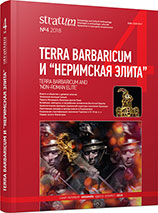Археологический текстиль и его значение при решении вопросов социально-этнической и религиозной принадлежности населения египетской хоры в греко-римское время: по материалам некрополя Дейр аль-Банат (Фаюм)
Archaeological textile as a source on social, ethnic and religious identity of the Egyptian provincial population in the Graeco-Roman period: by evidence from Deir al-Banat necropolis
Author(s): Olga V. Orfinskaya, Elena G. TolmachevaSubject(s): History, Archaeology, Cultural history, Social history, Ancient World
Published by: Издательский дом Stratum, Университет «Высшая антропологическая школа»
Keywords: Ptolemaic Egypt; Roman Egypt; archaeological textiles; textile production; vertical loom; funerary rite; mummification; Fayoum; Deir al-Banat; Christianity in Egypt; social structures
Summary/Abstract: The studies of textile finds from Graeco-Roman cemeteries in Egypt are of great importance due to many reasons. Specific climate conditions together with dry sand soils provide the unique state of preservation for organic materials. Therefore, archaeological textile could be considered as a main source for social, economic, ethnic and religious studies of the Egyptian society in the Graeco-Roman period. Technological studies of textiles could shed light on different questions concerning importance of textiles of different qualities among the grave goods, or the Egyptian textiles can be studied as a marker of social and religious status of the deceased. Archaeological textiles could help trace changes in the funerary rite, which happened due to Christianization of the Egyptian province in 3rd—4th centuries. The results of the study confirmed our preliminary hypothesis about the identity of the people buried on the necropolis. Most of Deir al-Banat population could belong to the mixed Greek-Egyptian middle class who practiced Egyptian pagan religion and funerary rites. Egyptian traditions were preserved also in the economic sphere, specially, in textile production.
Journal: Stratum plus. Археология и культурная антропология
- Issue Year: 2018
- Issue No: 4
- Page Range: 219-237
- Page Count: 19
- Language: Russian
- Content File-PDF

